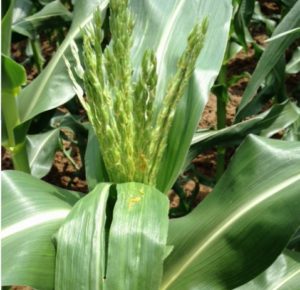Sweet Corn
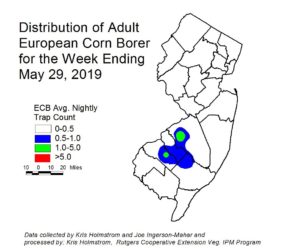 IPM Personnel are still capturing low numbers of European corn borer (ECB) moths, although even these captures are fairly sporadic, and extremely low in the northern counties (see map at left). Despite this, single digit feeding percentages were found on Middlesex county whorl stage corn on Wednesday of this week. It is likely that ECB injury has occurred on early plantings in most areas, although it is probably very light. Early plantings grown under plastic will be at risk first, followed by the first bare ground plantings. Growers should begin scouting whorl corn for injury.
IPM Personnel are still capturing low numbers of European corn borer (ECB) moths, although even these captures are fairly sporadic, and extremely low in the northern counties (see map at left). Despite this, single digit feeding percentages were found on Middlesex county whorl stage corn on Wednesday of this week. It is likely that ECB injury has occurred on early plantings in most areas, although it is probably very light. Early plantings grown under plastic will be at risk first, followed by the first bare ground plantings. Growers should begin scouting whorl corn for injury.
Look for the characteristic “shot-hole” type of feeding (photo below at right) and consider treating when infested plants exceed 12% in a 50 plant sample. As plantings proceed to the pre-tassel stage, ECB larvae may be found in emerging tassels (see photo at left). It is a good idea to treat individual plantings as they move into the full tassel/first silk stage one time. This eliminates any ECB larvae that have emerged with the tassels as they begin to move down the stalk to re-enter near developing ears.
Useful insecticides for this particular application include synthetic 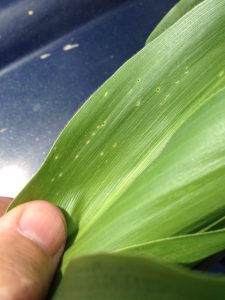 pyrethroids (IRAC Grp 3), spinosyns (including OMRI approved Entrust) IRAC Grp 5), and diamides such as Coragen (IRAC Grp 28) or materials such as Besiege which include the active ingredient in Coragen. Synthetic pyrethroids alone should NOT be used for corn earworm (CEW) protection on silking corn. Control with these materials is very inconsistent.
pyrethroids (IRAC Grp 3), spinosyns (including OMRI approved Entrust) IRAC Grp 5), and diamides such as Coragen (IRAC Grp 28) or materials such as Besiege which include the active ingredient in Coragen. Synthetic pyrethroids alone should NOT be used for corn earworm (CEW) protection on silking corn. Control with these materials is very inconsistent.
The highest nightly trap catches of ECB for the week ending 5/29/19 are as follows:
| Downer 2 | Centerton 1 | Hillsborough 1 |
| Medford 2 | Elm 1 | Jones Island 1 |
| Califon 1 | Folsom 1 | Oldwick 1 |
A few corn earworm (CEW) individuals are still being captured in southern blacklight traps this week. Catches occurred at Centerton and East Vineland in Cumberland County, Beckett, Salem County; Medford, Burlington County and Folsom, Camden County. These individuals likely represent a limited overwintered population to our south, and arrived on the southerly breezes that occurred over the weekend and early this week. The earliest plantings in southern NJ may be entering the silk stage now.
Although there are only very limited CEW pheromone traps operating at this time, it is notable that the Pedricktown and East Vineland sites captured 8-9 moths per night. This activity represents a low and probably short lived population brought here on southerly breezes. However, even this low level of moths presents a risk to early silking sweet corn locally.
Silking Spray Schedules*:
South – 6 days
Central – 7 days
*These recommendations are based on regional catches. Adhere to tighter spray schedules if indicated by local trap catches.
Cole Crops
Increasing numbers of imported cabbageworm (ICW) and diamondback moth larvae (DBM) infestations are now occurring, with DBM (see photo at right) being the dominant species. These infestations will increase rapidly as the spring season progresses. Check 5 consecutive plants each in 10 random locations throughout the planting, paying 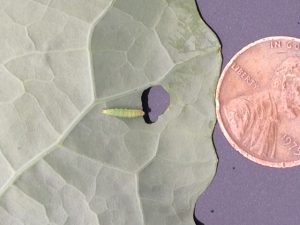 particular attention to the innermost leaves where ICW often feed. Consider treating if caterpillars are found on 10% or more plants that are in the 0-9 true leaf stage. From 9-leaf to the early head stage (in broccoli, cauliflower, and cabbage) infestations up to 20% may be tolerated. Once heads begin to form, a 5% threshold should be observed to protect the marketable portion of the plant. For leafy greens such as collards and kale, 10% plants infested is the threshold throughout.
particular attention to the innermost leaves where ICW often feed. Consider treating if caterpillars are found on 10% or more plants that are in the 0-9 true leaf stage. From 9-leaf to the early head stage (in broccoli, cauliflower, and cabbage) infestations up to 20% may be tolerated. Once heads begin to form, a 5% threshold should be observed to protect the marketable portion of the plant. For leafy greens such as collards and kale, 10% plants infested is the threshold throughout.
As a reminder: Some populations of DBM are resistant to carbamate and synthetic pyrethroid insecticides. The lack of DBM control with these insecticides has been noted in NJ previously. It is important to distinguish between common cole crop pests for this reason. DBM larvae grow to a length of approximately 0.5”, and taper toward both ends. These caterpillars thrash violently when disturbed. ICW grow to a length of approximately 1.25” and are covered with short hairs. Newer chemistries that specifically target caterpillar pests are effective against DBM as well as all other caterpillar pests of cole crops. These materials include (active ingredient – trade name (IRAC* code)):
Spinosad/Spinetoram – Entrust/ Radiant (5)
Chlorantraniliprole – Coragen (28)
Cyantraniliprole – Exirel (28)
The IRAC group 5 insecticide, Entrust, is OMRI approved for organic production. Insecticides based on the soil-inhabiting bacterium Bacilllus thuringiensis (B.t.) may also be effective on caterpillar pests of cole crops. Examples include Xentari and Javelin.
Flea beetles will be active in many plantings, particularly during the warmer days. These pests have a preference for the “hotter” flavored crops like arugula, mustard greens, and turnip greens. They also attack Tuscan or lacinato kale frequently. Plants may be protected with at-planting, soil-applied neo-nicotinoid insecticides (see the 2019 Commercial Vegetable Production Recommendations for products). An OMRI approved foliar material for flea beetle management is Pyganic. This product will provide knock-down of flea beetles, but may need to be applied frequently on preferred host crops.
Tomatoes
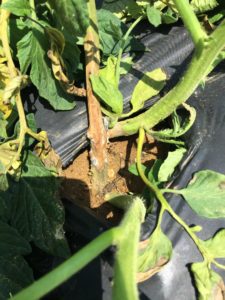 Timber rot (Sclerotinia) (photo at left) is showing up in many field and high tunnel grown tomatoes at this time. This fungal disease is favored by wet conditions and cool temperatures. Spores infect t
Timber rot (Sclerotinia) (photo at left) is showing up in many field and high tunnel grown tomatoes at this time. This fungal disease is favored by wet conditions and cool temperatures. Spores infect t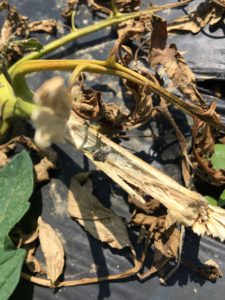 he main stems of the plants, causing them to wilt, with the stems turning dry and brittle. Closer inspection of these lesions will show the black sclerotia (photo at right), as are characteristic of this disease. These pellet-like masses of fungal tissue will drop to the ground as the plant deteriorates, and will serve as inoculum for the following season. For this reason, infected plants should be removed from the field or high tunnel. Sclerotinia can infect tomatoes, peppers, beans, lettuce and brassica crops.
he main stems of the plants, causing them to wilt, with the stems turning dry and brittle. Closer inspection of these lesions will show the black sclerotia (photo at right), as are characteristic of this disease. These pellet-like masses of fungal tissue will drop to the ground as the plant deteriorates, and will serve as inoculum for the following season. For this reason, infected plants should be removed from the field or high tunnel. Sclerotinia can infect tomatoes, peppers, beans, lettuce and brassica crops.
